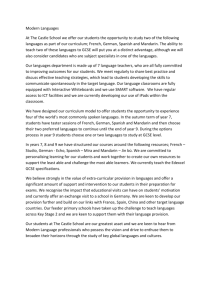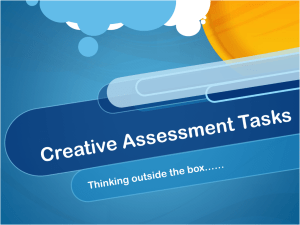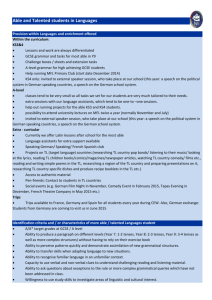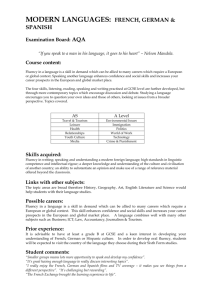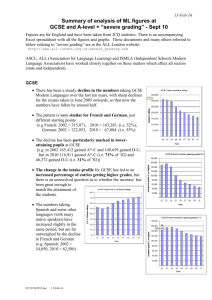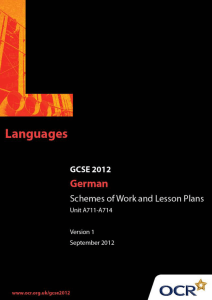Chenderit School - good practice example
advertisement
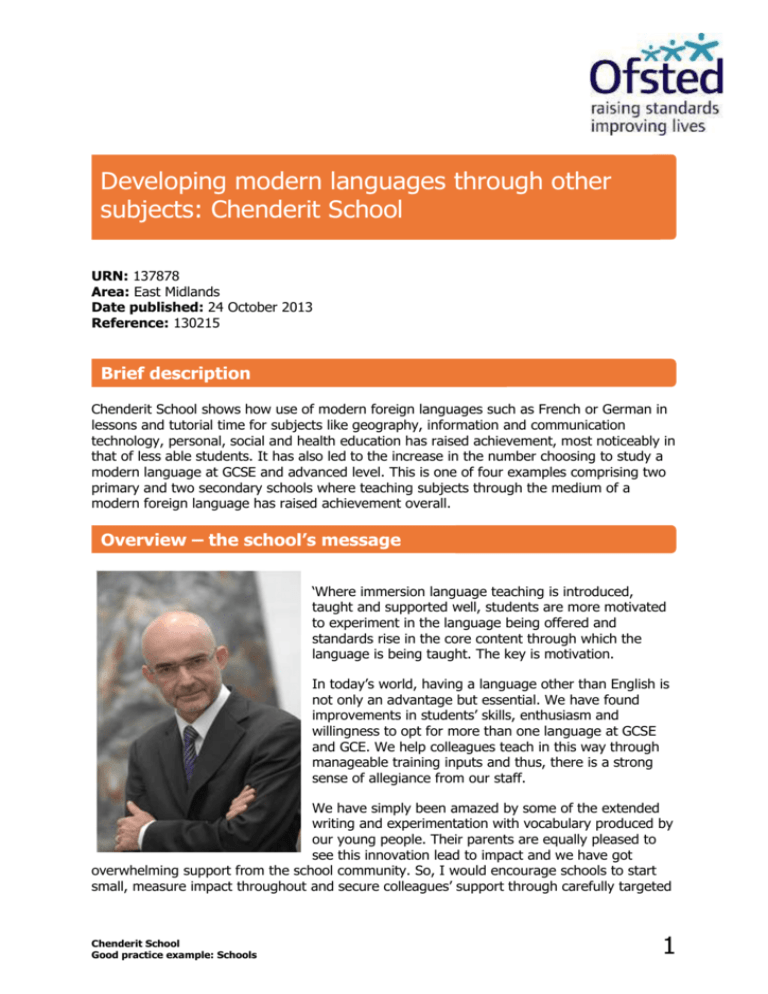
Developing modern languages through other subjects: Chenderit School URN: 137878 Area: East Midlands Date published: 24 October 2013 Reference: 130215 Brief description Chenderit School shows how use of modern foreign languages such as French or German in lessons and tutorial time for subjects like geography, information and communication technology, personal, social and health education has raised achievement, most noticeably in that of less able students. It has also led to the increase in the number choosing to study a modern language at GCSE and advanced level. This is one of four examples comprising two primary and two secondary schools where teaching subjects through the medium of a modern foreign language has raised achievement overall. Overview – the school’s message ‘Where immersion language teaching is introduced, taught and supported well, students are more motivated to experiment in the language being offered and standards rise in the core content through which the language is being taught. The key is motivation. In today’s world, having a language other than English is not only an advantage but essential. We have found improvements in students’ skills, enthusiasm and willingness to opt for more than one language at GCSE and GCE. We help colleagues teach in this way through manageable training inputs and thus, there is a strong sense of allegiance from our staff. We have simply been amazed by some of the extended writing and experimentation with vocabulary produced by our young people. Their parents are equally pleased to see this innovation lead to impact and we have got overwhelming support from the school community. So, I would encourage schools to start small, measure impact throughout and secure colleagues’ support through carefully targeted Chenderit School Good practice example: Schools 1 and constantly updated training. The benefits to the students and staff are well worth the investment in time.’ Graham Tyrer, Headteacher The good practice in detail Students achieve very well in German, French and Spanish. The proportion studying a language in the sixth form is rising every year. Achievement across the academy is improving and it was graded outstanding at its last inspection. When the curriculum review was carried out in 2007 and immersion teaching in French and German was introduced in a variety of subjects, the school was judged to be good. Careful analysis of the impact of the changes was built into the process; the academy now holds convincing evidence of the contribution the changes have made to these improvements. Modern languages (ML) are viewed positively by students of all levels of ability. A survey showed that 78% of students in Year 7 believe you do not have to be clever to succeed in the subject and that it is normal to make mistakes. This ‘can do’ attitude is clear in other year groups and demonstrated by the increasing number of students who choose a language as one of their GCSE subjects. They are confident speakers; a group of students gave a presentation about the rainforest wholly in German to all staff at a morning briefing. Throughout the week, students have discrete modern language lessons. These are supplemented by opportunities to be immersed in the language and develop their listening skills. The academy based the allocation of time on the model generally used in European countries for the teaching of the first foreign language. Students in Years 7 and 8 receive two hours of French or German lessons plus one hour of geography or ICT in the foreign language. The academy describes additional language input, such as one hour of personal social and health education and additional reinforcement in tutor time, as satellite extras. In Year 8, Spanish is added, so that in Year 9 students can choose which language or languages they wish to study for GCSE. The model ensures that all 2 Chenderit School Good practice example: Schools students receive some ML teaching. Those that have been disapplied from the core ML lessons are also exposed to other languages through other subjects and have some basic 1:1 instruction at other times. Teaching in the other subjects is delivered through the medium of French or German by specialists in those subjects who are fluent speakers. The content of the lessons is not compromised or reduced and assessment is securely moderated and accurate. The ML being used is not the key focus of the lesson and this is a major strength because it allows the students to experiment with the language without fear of making mistakes. Their writing is therefore highly creative and they are able to understand and react to exceptionally challenging written and spoken language. When writing for their ML lessons, the additional focus on structure and accuracy results in very high levels of French and German; GCSE speaking assessments taken at the end of Year 9 indicate a high proportion are already achieving an A* grade. Students are generally positive and see the advantages clearly. One student said that she was much more confident to volunteer answers in class, not just in these lessons but across the curriculum. They recognise the impact of the regular reinforcement of vocabulary on their progress in ML. One student described it as ‘soaking in the French’. Enjoyment is enhanced by talking about ‘more realistic things that you really want to say’. They said that personal qualities of perseverance and problem-solving that they can sense are improving. They recognise the impact the approach is having on their progress in other subjects. For example, they know that they have to pick out the most important aspects of what teachers are saying and this helps them in other subjects, such as science. One student spoke of using the same techniques in ML and science to learn the names of chemicals which she described as ‘just another language’. Hearing the language all the time strengthens listening skills and students feel better equipped to deal with listening tests because ‘you just know in your brain what it is’. The school’s background Chenderit School is a larger-thanaverage secondary school and is a specialist college for the visual arts. It draws its students mainly from villages in the south of Northamptonshire, but a few students travel from Banbury in Oxfordshire. A very large majority of students are of White British background. Very few students have a first language other than English. The school became an academy in March 2012. It is a Consultant School with the Specialist Schools and Academies Trust. It gained a LinkedUp award for Content and Language Integrated Learning in 2010. It has the Specialist Schools and Academies Trust Every Child Achieves Award for literacy across the curriculum. Other examples published in this set Dallam School Springfield Lower School St Austin's Catholic Primary School Chenderit School Good practice example: Schools 3 Are you thinking of putting these ideas into practice; or already doing something similar that could help other providers; or just interested? We'd welcome your views and ideas. Get in touch here. To view other good practice examples, go to: www.ofsted.gov.uk/resources/goodpractice 4 Chenderit School Good practice example: Schools
